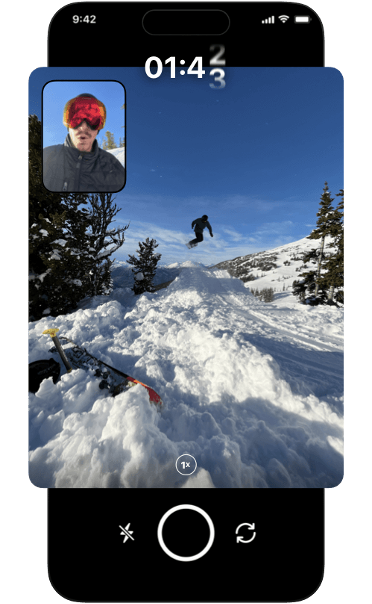College Students and Impression Management on BeReal
Ananya Reddy & Priya C. Kumar / Pennsylvania State University
BeReal has created a name for itself, especially among U.S. college students, as a more “authentic” form of social media, with a 315% growth rate in 2022. The app’s creators bill it as a recourse from the curated, filtered visions of life that populate the feeds of dominant platforms like Instagram. “We want to make people feel good about themselves and their lives,” the company said in a statement to The Verge. “We want an alternative to addictive social networks fueling social comparison and portraying life with the goal of amassing influence.” Its Apple App Store app description pronounces that “BeReal is your chance to show your friends who you really are, for once.”
In contrast to the feature-laden apps that dominate many young adults’ social media ecosystems, BeReal offers a pared-down interaction experience. Users can only post once per day, in a random two-minute window defined by the app. Users can’t edit their photos, but they can re-take them as many times as they want within the window. Images posted after two minutes are marked late. And users have to post their own images before they can see ones from their friends.
Does such a structured user experience reduce the pressures of social media posting? To find out, we are interviewing college students about how BeReal fits into their social media ecosystem. College students are an important demographic for BeReal, which hires students as brand ambassadors to promote the app on campuses. So far, we have interviewed fourteen undergraduate students at a large U.S. university, discussing how they use BeReal, how they feel about its features, and how they approach questions of authenticity and social media. The research was approved by our university’s Institutional Review Board, and we are beginning to analyze our data using an inductive approach to develop codes based on the project’s research questions (Seidman, 2013). Our initial findings suggest that while students appreciate seeing their friends do more mundane activities, they still experience impression management challenges (Picone, 2015).
College Students’ Views on BeReal’s Design Features
BeReal embodies a different, more structured approach to social media. The platform constrains users to posting at a random time dictated by the app. Often, this means users post images of mundane moments; our participants reported posting about doing homework, eating, or walking to class. Some participants expressed excitement at receiving the BeReal notification at an opportune moment, where they perceived themselves doing something “cool.” One received the notification while attending a major football game and said they remembered thinking, “I’m so happy it went off at this time.” This suggests that social media users still sense that certain moments of one’s day are more worth capturing than others. BeReal controls when the notification comes, but this lack of control doesn’t prevent users from trying to craft interesting posts, even within the confines of a two-minute window. As one participant noted, “There’s definitely a drive to shake it up a little bit, because you know, your friends are going to see it, and if they see the same thing…it kinda pushes you to do new things.”

Limiting users to capture an image at a randomized time makes it harder to stage pictures, but it can also introduce pressure to make life seem “interesting” even when caught off-guard. For instance, the random posting window of two minutes means users must post about their immediate surroundings, regardless of how significant they are. One participant said the notification almost always came when they were doing homework or on their computer, so that was what their friends saw, even if they did other things during the day. “I would say it is not a very honest portrayal of my schedule,” they said. “It is only one moment.” The absence of important relations, like friends, in posts, can also be disconcerting. One participant stated, “It’s the constant feeling that you want people to know you have friends.” In other words, the way the pressures manifest may be different, but they exist just the same.
Our findings suggest that the content of posts may matter less than the act of posting. BeReal promises connection not by showing users the best moments of their friends’ lives, but by creating moments for them to exchange what they’re doing at the same time. Most participants said they spend 15-20 minutes on the app per day and that they appreciate being able to quickly see what people are up to. More than one participant said BeReal helped maintain their bond with friends abroad by letting them know what their friends are up to and that their friends are okay and having fun, despite not seeing or speaking to each other much outside the app. Another participant recalled checking BeReal and seeing a picture of their friend feeding goats: “It felt nice…seeing that it was what they were doing randomly. It didn’t seem like it was a picture ‘specially taken because they were with goats.” Although petting goats was an unusual activity, the participant valued not the photo, but the sense of knowing what their friend was doing at the time.
And BeReal cares about time. The app marks posts made after the two-minute window “late” and notifies friends about the tardiness. As one participant noted, “it kinda teases you for not being on your phone all the time.” BeReal’s founders position the app as an alternative to “addictive” social media apps, but our participants find that the app nonetheless expects users to make themselves constantly available. Some participants fleetingly acknowledge late postings but don’t appear to dwell on it. “It’s not really a big deal,” said one participant. “In reality, we’re all too invested in ourselves to think about other people.” Our initial analysis suggests that college students value BeReal for helping them sustain important friendships and offering glimpses into their friends’ lives that they might not typically get elsewhere. However, the question of whether the app’s highly constrained user experience produces a more “authentic” representation of one’s life is complicated, given that our participants still find themselves navigating impression management goals (Picone, 2015).

Impression Management on BeReal
If the problem of social media is that it presents a fictionalized, idealized view of life, then, BeReal purports to offer a solution by constraining the user experience so users have no choice but to post what is really going on. At first glance, this appears a helpful, even welcome, response to public concerns about social media leading to reduced wellbeing. However, by emphasizing planning and curation as the sources of inauthenticity on social media, BeReal risks portraying any act of impression management as problematic.
BeReal’s randomized, two-minute posting window limits users’ ability to pre-plan their posts, seemingly reducing their ability to curate what image of themselves they portray online. The app does not enable users to edit their photos, seemingly responding to filters and other features that can encourage users to present an idealized image to an audience. However, as exemplified in participant responses, students still experience a desire to portray a certain version of themselves, not despite the random posting window, but because of it. Images will most likely portray mundane activities, yet users still experience pressure to make even the day-to-day seem interesting to friends on the platform. Hence, the need to manage impressions is not absent, just different. This holds true also considering that the app uses photography as its primary medium, a form of expression that is often regarded as more realistic than others but nevertheless remains highly constructed (Sontag, 1977). Indeed, despite what BeReal’s rhetoric suggests, performing and modifying the self to cater to a specific audience is not inherently inauthentic (Picone, 2015).
BeReal’s user experience, while novel, does not immediately create a more “authentic” online persona. This is not to say that designers should abandon goals to greater authenticity online. In a Data & Society report on technology and wellbeing, researchers Amanda Lenhart and Kellie Owens (2020) discuss how instead of tackling problems with more design, the tech industry must also consider cultural shifts and privilege a broad and diverse range of user experiences. Fostering more authentic social media interactions requires more than just new features on social media. It also requires grappling with the need for healthier beauty standards and safer online spaces (Xiao et al., 2020). BeReal’s entry into young adults’ social media ecosystems prompts deeper questions for scholars and practitioners alike: Can we ever be our authentic selves online? What do we need to do to ensure design decisions are made in accordance with diverse user needs?
Image Credits:
- BeReal quickly gained popularity among U.S. college students in 2022. Source: Wikimedia Commons.
- BeReal users have two minutes to capture images from their front and back cameras for a once-a-day post. Source: Screenshot from BeReal website.
- While many people believe that curating how we portray ourselves means masking our identities, impression management theory explains that such curation is a normal part of everyday life. Source: Pixabay.
Lenhart, A., & Owens, K. (2020, October 7). Good intentions, bad inventions: The four myths of healthy tech. Retrieved January 14, 2023, from https://datasociety.net/wp-content/uploads/2020/10/Healthy-Tech-Myths-DataSociety-20201007.pdf
Picone, I. (2015). Impression management in social media. The international encyclopedia of digital communication and society, 469-476.
Seidman, I. (2013). Interviewing as qualitative research: A guide for researchers in education & the social sciences (4th ed.). Teachers College Press.
Sontag, S. (1977). On photography. Farrar, Straus and Giroux.
Xiao, S., Metaxa, D., Park, J. S., Karahalios, K., & Salehi, N. (2020). Random, Messy, Funny, Raw: Finstas as Intimate Reconfigurations of Social Media. Proceedings of the 2020 CHI Conference on Human Factors in Computing Systems, 1–13. https://doi.org/10.1145/3313831.3376424
